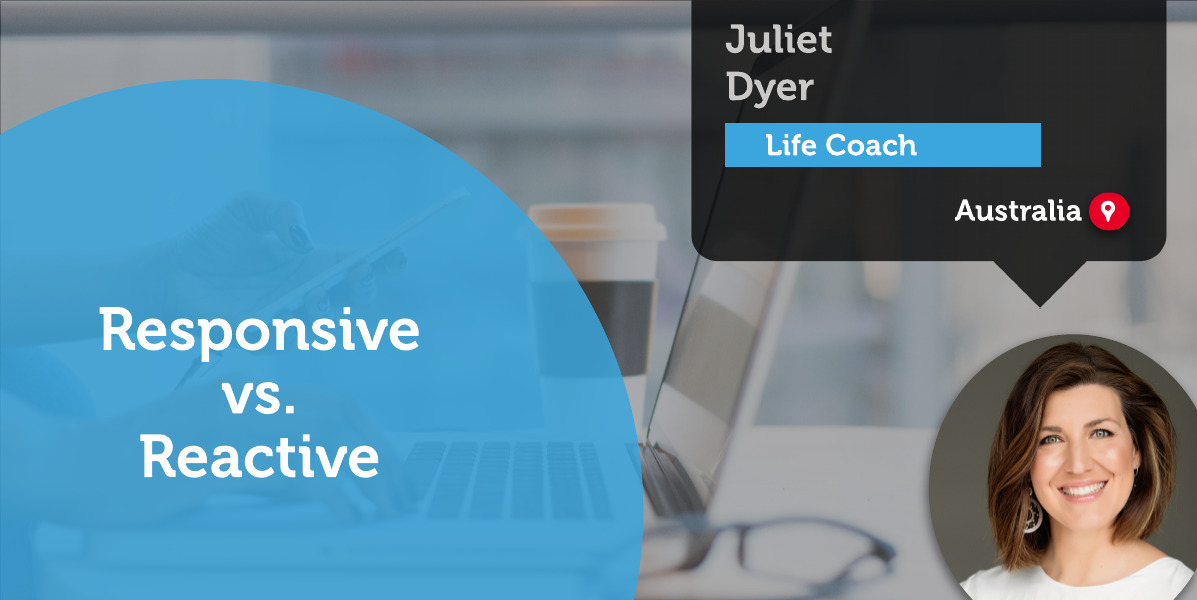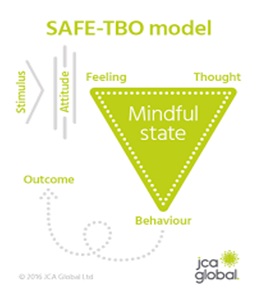A Coaching Power Tool By Juliet Dyer, Life Coach, AUSTRALIA

There is a significant difference between being reactive versus being responsive. Some may say that it’s just semantics but imagine a world where you can choose how you show up at any given moment. A world where you are in control of your behaviour; of what you say and how you react to the world around you.
The Significant Difference Between Responsive vs. Reactive
Reactive
We have all experience done of those moments in life where, in the heat of the moment, something has come out of our mouths and then a split second later we are beating ourselves up inside and instantly regret what we have said or the action we have taken. Reactive behaviour is immediate and occurs without conscious thought, like a knee-jerk reaction. It is often driven by emotion, where you may find yourself lashing out, shutting down or fighting. Typically, you behave like a victim of events and are not fully in control.
Responsive
On the other hand, people who are responsive rather than reactive are generally calm. They are easygoing and they don’t get stressed easily. They take time to think things through, are generally good at planning and looking ahead. They are considered with their responses. They have empathy. Most importantly they don’t take things personally. They can look objectively at situations and not get ‘caught in the emotion of it. They can take ownership, responsibility and accountability for all the good and not so good things that occur in their lives. They generally have a positive outlook on life, have great relationships and are well-liked.
The Science Behind Responsive vs. Reactive
Daniel Goleman refers to a reactive response as an amygdala hijack. He states that the three signs of having experienced an amygdala hijack are:
- Sudden emotional response/outburst
- Very negative emotions playing out (anger, fear, blame, insecurity)
- When it’s all over and the dust has settled you regret what you said or did.
Within our brain when we receive stimuli (an event occurs), the information is sent to our limbic system and our Amygdala scans that information looking for any dangers or threats, it’s like our guard dog. In terms of threats, the amygdala responds to threats that have been learnt through experience, such as having a fear of public speaking. If our guard dog detects any danger or threats it responds by triggering a very powerful emotional response known as our fight or flight response, which then shuts down access to our higher thinking brain, the prefrontal cortex. Our prefrontal cortex is the part of the brain that can make conscious choices, be self-aware and use willpower to override our emotional impulses. It is our thinking brain.
So, if our reactive behaviours are triggered by our amygdala and our responsive behaviours occur in our prefrontal cortex how do we change our attitude to different stimuli so that we can take control of our behaviour? The trick is working out the stimulus, or the trigger, that creates the reactive behaviour and learning to pause.
Between Stimulus and Response there is a space, in that space lies our power to choose our response. In our response lies our growth and freedom. Viktor E. Frankl
How Does This Play Out?
Research in psychology and neuroscience has shown us that when we receive information (stimulus) it is initially filtered through our attitudes before being processed as feelings, emotions and thoughts. It is believed that our attitudes drive our behaviours. This is clearly shown by the SAFE-T BO Model that was created by Maddox and Sparrow.
 S – Stimulus
S – Stimulus
A – Attitude
F E – Feeling / Emotion
T – Thought
B – Behaviour
O – Outcome
It should be noted that our outcome can also be the stimulus, which is why in some cases people can get stuck in the repetitive cycle of how they feel, think and behave.
To demonstrate how this model works within the workspace, imagine the following scenario:
James has just completed a complex piece of work that he has spent hours on. He is very proud of what he has created and is looking forward to showing his boss and then presenting the work to his peers at the next team meeting.
James excitably sends his boss the document via email and eagerly awaits his response.
The next day, James receives an email from his boss about his work. The first comment is great job! Then James opens the document, and the Boss has corrected quite a few grammatical errors. James sees all the corrections (STIMULUS) and automatically thinks “I’m hopeless at my job” (ATTITUDE).
Immediately Janes starts feeling upset/insecure about his capabilities at work (FEELING/EMOTION), even though the initial response from his boss was ‘great job!’
James then states thinking to himself “why should I bother?”(THOUGHT)
This thought then leads to Jameswithdrawing (BEHAVIOUR) from his boss and other colleagues and showing no enthusiasm(BEHAVIOUR) to presenting his work to his peer at the team meeting. As a result, his boss doesn’t understand why James is withdrawing and showing a lack of interest and assumes he doesn’t want to give the presentation, so the boss gives the presentation himself (OUTCOME). This outcome then becomes the next stimulus that re-enforces his attitude of “I’m hopeless at my job.”
In this scenario the reactive response was James withdrew and showed no interest in presenting his work. Instead of looking at the corrections and thinking to himself “Next time I should spell check my work before I send it,” he went into an emotional hijack and reacted accordingly.
Being reactive in the workplace is bad business, especially if you are a leader. At this level, your technical skills (IQ) are not needed as much as your people skills, and this is where Emotionally Intelligence comes into play. According to Daniel Goleman, the 5 top reasons for having a reactive response aka an Amygdala Hijack to occur within the workplace are all because of feelings of:
- Not being appreciated
- Not being respected
- Not being heard
- Not being treated fairly
- Not getting credit for the work you do
If you don’t like something, change it.If you can’t change it, change your attitude. Maya Angelou
How Do You Flip From Responsive vs. Reactive?
We need to build our emotional intelligence by strengthening our cognitive control. We do that by improving our attitudes, our awareness of ourselves and others and our regard for ourselves and others. Maddox and Sparrow list the below items as 6 ways to improve your EI:
- Remove or change the negative stimuli
- Change your attitude
- Bring in relaxation techniques to calm down your emotions
- Bring in techniques that help to quieten the noise in your mind
- Continue to practice the new behaviour you want to adopt
- Focus on a positive outcome
Self-Awareness is key to shifting from reactive to responsive, as it can be challenging for someone to identify the difference between reactive behaviour versus responsive behaviour. Identifying when emotions are driving our behaviour requires a level of emotional intelligence, which in turn will allow us to manage our emotions through rational thinking.
Questions to Support Moving From Reactive to Responsive:
- What specifically created that reaction from you?
- What was it about that event that provoked your defences?
- What attitude/underlying belief did it bring up for you?
- What emotions/feelings did it bring up in you?
- What internal chatter/thoughts did you have?
- What are your thoughts on the behaviour it elicited from you?
- What outcome did that behaviour give you?
- What’s important to you about responding differently?
- What could you gain personally by changing from reactive to responsive?
- What impact would that have for you at work / as a leader?
- What could you have done differently?
- What would need to change in your mindset to shift your attitude?
- What have you learnt about yourself?
- What have you learnt about the situation?
- What actions can you take to help calm your emotions?
- What action can you take to quieten down the noise in your mind?
- What can you put in place to help support your new behaviour?
- What will help you stay focused on the outcome you wish to achieve?
Having the ability to flip your mindset and your actions from being responsive to reactive allows you to be in the driver’s seat of your life. Being responsive means, that when something happens in your life, an external event of some kind, you can pause, to step back from the emotions and feelings that the event brings up in you and be able to look at it objectively allowing you to then “think” your way into a response instead of automatically reacting.
References
Riopel, L Positive Psychology.
Assessments/emotional intelligence profile
Importance of emotional intelligence
Maddocks, J Emotional Intelligence At Work How To Make Change Stick, Spa House Publishing, Cheltenham, Gloucestershire, UK.
Neale, S., Spencer-Arnell, L., Wilson, L. Emotional Intelligence Coaching; Improving Performance for Leaders, Coaches and the Individual, Kogan Page, London
Goleman, D. Emotional Intelligence Why it can matter more than IQ, Bloomsbury, London
Signs of low emotional intelligence
12 leadership competency primers